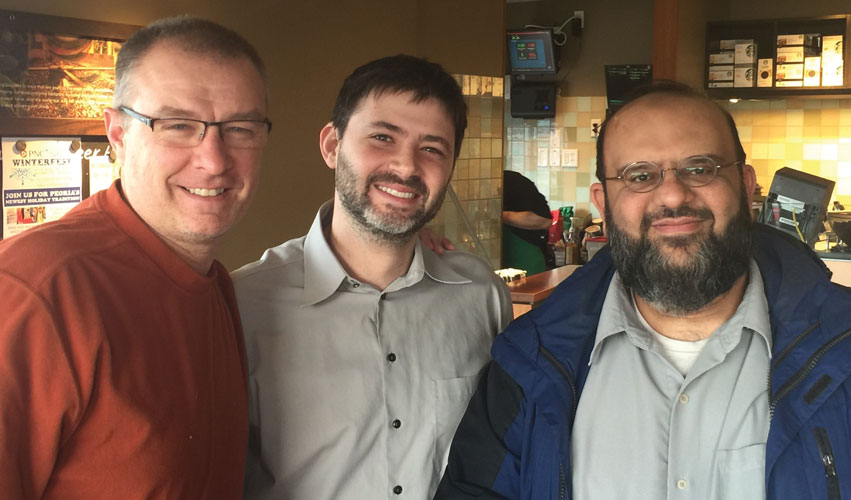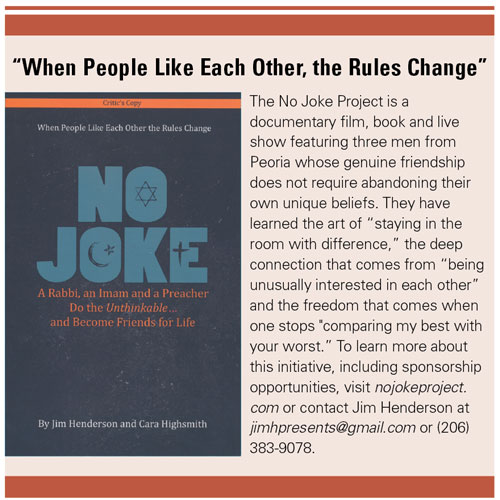
Three practices to build bridges across difference… and find new ways to think about old problems.
People with very different ideological views founded this country. They approached the American experiment hoping for different outcomes: some wanted more of what they already had with Britain, while others aspired to a one-man, one-vote system. Some wanted to retain slavery, while others did not. Eventually, these differences led to the bloodiest war in our history, the Civil War. That war officially ended in 1865, but it has continued to be litigated by each succeeding generation via political means.
Today, when it comes to ideologies, we find ourselves more divided than ever:
- Gay/straight;
- Pro-life/pro-choice;
- 1%/99%;
- Black Lives Matter/All Lives Matter;
- Saved/lost;
- Red state/blue state…
You get the idea. Under the right set of circumstances, those differing viewpoints can provide the kindling that sparks people to fight with each other—and nations to go to war.
This is what I call the difference divide, and as you already know, that divide is expanding by the minute. “Otherizing”—the practice of minimizing, denigrating and categorizing those who disagree with “me”—is becoming a familiar part of our vernacular. As the online satirical magazine The Onion recently joked, “Stereotypes have become real time-savers.” A recent CNN survey found that “the sense that the country is sharply riven is near universal, with 85 percent saying so overall, including 86 percent of independents, 85 percent of Republicans and 84 percent of Democrats.”
How is it that two people can look at the same picture and see two different things?

We live in dangerous times, which makes the opportunity for influence even greater… because when people are anxious, they’re open to new ways of thinking about old problems. They’re ready to consider the possibility that how we think about a problem is often more important than how we solve it.
A Quest for Difference
Over the past 15 years, my curiosity as a spiritual anthropologist has prompted me to search out people who are actively exploring ways to cross the difference divide. It started when I began asking people to tell me their thoughts about things I’d felt fairly certain about. This quest led me to read and study both business and war books—I wanted to know how people responded in real time to guns aimed at them, or to shifting markets facing them. A couple of traits quickly became apparent:
- They studied their enemy almost to the point of admiration; and
- They spoke directly with their customer.
While reading Ries and Trout’s The 22 Immutable Laws of Marketing, I was introduced to the law of focus. I was pastoring a church at the time, so that’s where I decided to bring my focus. I hired young people to attend my church to critique my sermons, and paid them $25. These non-Christian young people were my target market: the kind of people I wanted to convert, though I had been unsuccessful at getting them to agree to my terms.
As fate would have it, around this time I also stumbled upon an undergrad atheist in Chicago who was selling his soul on eBay. His offer? For every $10 raised, he would attend the winning bidder’s church for an hour. I won. My bid: $504. However, instead of sending him to 50 churches, I sent him to 10 churches and asked him to blog about his experiences for 50,000 people. That led to a front-page story in The Wall Street Journal, 30 days of intense media coverage, and a book offer.
I then hired another atheist to co-author a book of church reviews (think “Yelp for church”). That book was Jim and Casper Go to Church.
The common thread in each of these projects was my desire to discover what I had in common with people with whom I shared significant differences. That desire led me to develop “The Three Practices.”
The spiritual anthropologist in me kept turning over relational rocks trying to see things from the “dark side” (or, just the other side). I kept picking at things that seemed invisible to the naked eye to see what was really going on beneath the surface. I’d ask my atheist colleagues to tell me what they saw when I took them to church, what they heard when I used religious language, and how it felt when someone called them a name or dismissed their opinions as “alternative facts.”
The No Joke Project
In May of 2016, I got a call from a pastor in Peoria named Jim Powell. He had read my book and wanted to tell me about the relationship he had forged with a rabbi and an imam in his community. Together, they had hosted a couple of public events called “Peace for Peoria,” where they brought together large, diverse groups of people to help them better understand Muslims.
My team and I flew out from the west coast and spent a week with these three gentlemen. We shot footage, took notes and put together a project we now call The No Joke Project: A Film.Book.Tour. Since June, we’ve produced a documentary film; written a 140-page book; presented a premiere in Peoria attended by 200 Muslims, Jews and Christians; raised $100,000 to cover the production costs; and are now in the preparation stages for our first tour in March.
All that in six months! No joke!
 I have studied explorers like Columbus and Magellan. Some explorers return, saying, “You should have seen what I saw,” while others come back with a map. The “Peoria Three,” as I call them, had successfully crossed the rocky terrain of the difference divide. All they lacked was a map laying out their path so others could follow in their footsteps.
I have studied explorers like Columbus and Magellan. Some explorers return, saying, “You should have seen what I saw,” while others come back with a map. The “Peoria Three,” as I call them, had successfully crossed the rocky terrain of the difference divide. All they lacked was a map laying out their path so others could follow in their footsteps.
When I met the Peoria Three, I suggested that they were like a band, and I was like a songwriter. I had written a “song” called The Three Practices, and suggested we team up. I’d give them the song and they’d sing it everywhere, which is what we’re now doing.
The Peoria Three were drawn together by a mutual interest in protecting the imam and his community from the growing threats of Islamophobia, but their story has much wider implications. In this quest to protect their friend from discrimination, they inadvertently stumbled onto something even bigger—something that can help all of us cross the difference divide, be it religious, political or economic.
The Three Practices
I deliberately use the word “practices,” because all humans are capable of is trying, and then trying again.
- Practice being unusually interested in others. This is where we practice out-listening one another. Human beings are attention junkies. They like hearing “wow!” They think it means that we want to hear more.
- Practice staying in the room with difference. Based on the news, one would think the worst thing in the world is to discover we don’t agree. You voted for Trump and I voted for Hillary—now we have to break up! What if, instead, we could learn the art of co-belligerating—finding one small thing we can work on together, and ignoring the larger issues for a while—like my atheist colleague and I did.
- Stop comparing my best with your worst. Human beings resist being preached at or talked down to. We’re most open when we’re treated with dignity and respect. We don’t like parental, patronizing or contrived talk. We respond to people who “give ground.”
Peoria is a place of great diversity. Its companies and businesses have much to teach the rest of the country about developing a culture of respect and civility. By implementing “The Three Practices” as part of your diversity training, your position as leaders could be enhanced even more. iBi
Jim Henderson is a speaker, author and executive producer of The No Joke Project, based in Edmonds, Washington. He holds a doctorate in transformational leadership and has been featured in The Wall Street Journal, USA Today, Fox News and This American Life with Ira Glass.

